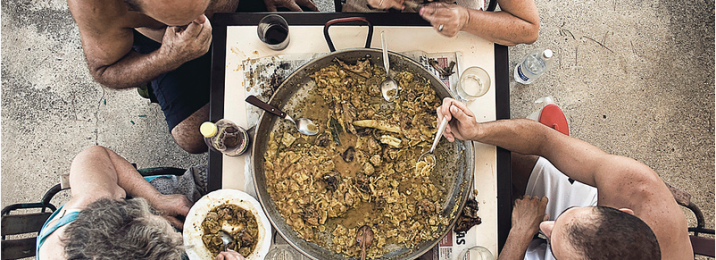Pure Paella
For a dish so quintessentially Spanish as paella (pronounced pa-EH-ya), you’d think there’d be only one way to make it – one cherished national recipe meticulously followed and kept intact down the ages by passionate master chefs. But the fact is, wherever you go in Spain, you’ll come across unique regional variations, with new ones popping up all the time.
This is because, contrary to popular opinion, paella isn’t a “national dish” at all, but a uniquely Valencian one. In order to understand paella from an historical standpoint, we have to look to the first known mention of it, to ‘paella zero‘ if you will.
Apparently invented by agricultural workers around Lago Albufera as a cheap and wholesome lunch to feed many hungry mouths (as many of our world wide favorite dishes), paella is traditionally cooked outside in a large round paellera pan over an open fire. Ingredients (besides the low-cost, absorbent, and satisfyingly starchy staple of bomba rice) were whatever they could find. This usually meant an abundance of seasonal vegetables, from tomatoes and bell peppers in hot weather, to artichokes and beans through the winter. The meat was likely to have been water vole and banded snails to begin with, later giving way to (one of our favorites) rabbit, duck and, for the wealthy, chicken as the dish surged in popularity.
Paella might also have been introduced by the Arabs, during their many invasions of Spain. Some people claim that even the name of the dish is a corruption of the Arabic baqiyah (meaning ‘leftovers’) that were used by their servants to make it. This theory could at least explain the inclusion of the luxurious Persian spice, saffron, in an otherwise peasant dish. Certainly the Arab perfection of Spain’s agricultural irrigation for rice cultivation is well-documented, with the Spanish word for rice, arroz, coming directly from the Arabic.
Another origin story holds that paella was created out of one man’s love for his wife, and that he original named the dish por ella (“for her”). Though less a theory than a quaint and romantic myth, it’s still interesting to note that, to this day, open-air paella chefs tend to be male (in much the same way that barbecues across America tend to be the sole domain of tong-and-beer-wielding men).
To return to the facts, the first ever recorded mention of the word paella was in a Valencian newspaper report in 1840. The name was coined from the dish it was cooked in – an understandable choice, given that the paellera was also the traditional receptacle from which to eat it, each person marking out their triangle with a wooden spoon and consuming their share from the edge of the pan to the centre.
In fact, this social element to paella, so common to all Spanish cuisine, lives on in the inclusive atmosphere that surrounds paella preparation in the home, with everyone pitching in, as well as the party-like paella picnics that many families and friends drive out to the mountains or the beach for – a chance to drink wine and cook great food, all the while debating over the right way to make it. Speaking of which…
Paella Valenciana: “The Right Way”
Though they’ll no doubt quibble with you over the details, most Spaniards agree that the right way to make paella is the Valencian way. What’s the Valencian way? There isn’t one.
There are two hundred.
But in the interests of brevity and as a basic rule, a true paella valenciana must consist of chicken, rabbit, vaquetas (‘cow snail’), and beans, as well as, of course, the obligatory rice and spices.
The type of rice used will be white – either bomba or calasparra – both prized for their fat, round shape and high absorbency, perfect for soaking up all the succulent flavors that go into the dish.
Equally crucial are the traditional cooking vessels. These round, flat-based and cast iron paelleras range wildly in size, from around 12 inches across to several feet outdoors. Incidentally, the largest pan ever to be used measured 70 feet in diameter, held 6.6 tons of rice, double that weight in chicken and rabbit, and used well over 260 gallons of olive oil. The 35 pounds of saffron alone must have cost upwards of $100,000. This was a promotional stunt in Madrid, though, and it’s far from common practice!
The pans in common usage have little dimples across their base – a technical necessity for collecting pools of oil and broth and ensuring even cooking throughout, which is especially important when cooking in the open-air over natural fires. These would use the wood of trees native to the region, with the type being varied according to the desired cooking speed (logs for frying meat and orange and olive twigs for boiling the rice).
The typical process goes like this: First the olive oil is heated in the pan and the meat (i.e. sliced and salted rabbit and chicken) is sauteed to seal and brown on either side. Next come the beans (ferraura, rotjet, tabella and lima are all common alongside other varieties), as well as any other green vegetables being used. When these are soft, the heat is reduced and a space is cleared in the centre of the pan to add the flavorings (often grated tomato, garlic, snails and sweet or smoked pimienton. Water is then added with salt and the whole lot is given a stir and simmered evenly for a good twenty minutes. Next the rice goes in, enough to be level with the broth, and the paella is topped off with saffron to give it that rich, golden color so evocative of sizzling Spanish summers. After this, cooking goes on over a lower heat until the starch from the rice thickens the mix.
Finally (before you rush off to make your own), something to look out for is the crusty brown layer of rice better known as the socarrat that forms at the base of the pan. Far from a sign of overcooking, this is the crowning delicacy of a great paella and should be scraped up and eaten as an excellent and traditional side.


No comments
You can be the first one to leave a comment.